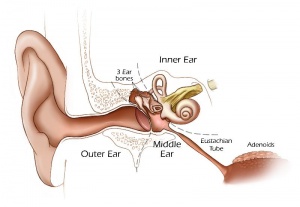2009 Lecture 17: Difference between revisions
No edit summary |
|||
| Line 14: | Line 14: | ||
* Essentials of Human Embryology Larson Chapter 12: p252-272 | * Essentials of Human Embryology Larson Chapter 12: p252-272 | ||
* Before We Are Born (5th ed.) Moore and Persaud Chapter 20: p460-479 | * Before We Are Born (5th ed.) Moore and Persaud Chapter 20: p460-479 | ||
==Objectives== | |||
* Understanding of structures and functions of the auditory pathway | |||
* Understanding of inner, middle and external ear origins | |||
* Understanding of timecourse of auditory development | |||
* Understanding of abnormalities of auditory development | |||
* Brief understanding of central auditory pathway and molecular development | |||
{{Template:2009ANAT2341}} | {{Template:2009ANAT2341}} | ||
[[Category:2009ANAT2341]][[Category:Science-Undergraduate]] | [[Category:2009ANAT2341]][[Category:Science-Undergraduate]] | ||
Revision as of 21:38, 24 September 2009
Sensory Development - Hearing
Introduction
We use the sense of balance and hearing to position ourselves in space, sense our surrounding environment, and to communicate. Portions of the ear appear very early in development as specialized region (otic placode) on the embryo surface that sinks into the mesenchyme to form a vesicle (otic vesicle = otocyst) that form the inner ear.
This region connects centrally to the nervous system and peripherally through specialized bones to the external ear (auricle). This organisation develops different sources forming the 3 ear parts: inner ear (otic placode, otocyst), middle ear (1st pharyngeal pouch and 1st and 2nd arch mesenchyme), and outer ear (1st pharyngeal cleft and 6 surface hillocks).
This complex origin, organisation, and timecourse means that abnormal development of any one system can impact upon the development of hearing.
Textbooks
- Human Embryology (2nd ed.) Larson Chapter 12: p375-409
- The Developing Human: Clinically Oriented Embryology (6th ed.) Moore and Persaud Chapter 19: p491-511
- Essentials of Human Embryology Larson Chapter 12: p252-272
- Before We Are Born (5th ed.) Moore and Persaud Chapter 20: p460-479
Objectives
- Understanding of structures and functions of the auditory pathway
- Understanding of inner, middle and external ear origins
- Understanding of timecourse of auditory development
- Understanding of abnormalities of auditory development
- Brief understanding of central auditory pathway and molecular development
Glossary Links
- Glossary: A | B | C | D | E | F | G | H | I | J | K | L | M | N | O | P | Q | R | S | T | U | V | W | X | Y | Z | Numbers | Symbols | Term Link
Course Content 2009
Embryology Introduction | Cell Division/Fertilization | Cell Division/Fertilization | Week 1&2 Development | Week 3 Development | Lab 2 | Mesoderm Development | Ectoderm, Early Neural, Neural Crest | Lab 3 | Early Vascular Development | Placenta | Lab 4 | Endoderm, Early Gastrointestinal | Respiratory Development | Lab 5 | Head Development | Neural Crest Development | Lab 6 | Musculoskeletal Development | Limb Development | Lab 7 | Kidney | Genital | Lab 8 | Sensory - Ear | Integumentary | Lab 9 | Sensory - Eye | Endocrine | Lab 10 | Late Vascular Development | Fetal | Lab 11 | Birth, Postnatal | Revision | Lab 12 | Lecture Audio | Course Timetable
Cite this page: Hill, M.A. (2024, May 18) Embryology 2009 Lecture 17. Retrieved from https://embryology.med.unsw.edu.au/embryology/index.php/2009_Lecture_17
- © Dr Mark Hill 2024, UNSW Embryology ISBN: 978 0 7334 2609 4 - UNSW CRICOS Provider Code No. 00098G
